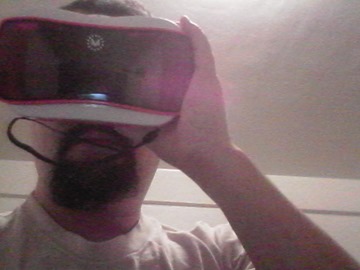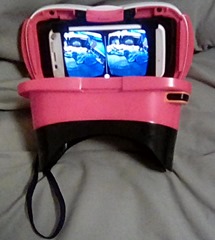 The other day, when I wrote about the potential future for VR in media, I happened to notice that the View-Master VR Google Cardboard viewer was on sale at the time for $20. Given that was little more than one of the flimsier cardboard versions cost, I figured why not give it a shot—and so I did. It arrived yesterday, and I’ve had the time to play with it a little. Here are my thoughts.
The other day, when I wrote about the potential future for VR in media, I happened to notice that the View-Master VR Google Cardboard viewer was on sale at the time for $20. Given that was little more than one of the flimsier cardboard versions cost, I figured why not give it a shot—and so I did. It arrived yesterday, and I’ve had the time to play with it a little. Here are my thoughts.
The View-Master VR Itself
 The VR viewer is made of the same sort of thick, heavy plastic as the View-Master picture disc viewers that I’m sure so many of us remember from our childhoods. No flimsy cardboard here! You open it up, slot the phone in, make sure the center divider is lined up with the line on the bracket that holds the phone in place, shut it again, and there you go. There’s also a button that you push, just as you might have done with the View-Master viewers of old—but instead of advancing a reel, this one makes a stylus nib come out and tap the middle of the screen.
The VR viewer is made of the same sort of thick, heavy plastic as the View-Master picture disc viewers that I’m sure so many of us remember from our childhoods. No flimsy cardboard here! You open it up, slot the phone in, make sure the center divider is lined up with the line on the bracket that holds the phone in place, shut it again, and there you go. There’s also a button that you push, just as you might have done with the View-Master viewers of old—but instead of advancing a reel, this one makes a stylus nib come out and tap the middle of the screen.
When you’re running a VR app, effectively your phone acts like one of those old stereoscope viewers that were the predecessor to the original View-Master. There’s one image for your left eye and one for your right, so you get a stereoscopic view. (In theory, at least. In actual practice, it’s generally the same frame for each eye, so you’re seeing a flat 2D image, but it moves around when you move the viewer, so at least that’s something anyway.)
In a way, it reminds me a lot of the “AppBlaster” augmented reality gun for the iPhone, which I once had a chance to play with (it wound up in a grab-bag box of cheap stuff I got from an on-line surplus vendor, and I gave it to my sister-in-law who had an iPhone). That gun, and the accompanying app, was also based on the idea of moving your phone around, and it also had a button (in this case, a trigger) that would trigger a little arm to tap the screen with a stylus nib. The idea was that aliens would fly around and you’d swing the gun around, aim at them, and shoot them. It wasn’t all that great—but happily, the View-Master VR is a considerably better implementation of a similar principle.
One problem I noticed is that pretty much every VR app starts out as a regular app, and you have to put it into VR mode and then close up the View-Master. But there’s not really any way around that, given that this gizmo is leveraging the existing hardware of your smartphone to do its thing.
Another, possibly larger problem is that there’s no face strap on this thing—you have to hold it up to your face for as long as the movie lasts. And that sturdy heavy plastic does start to get heavy after a while. Fortunate, most VR movies are pretty short these days.
View-Master Native Apps
In addition to being a Cardboard viewer, the View-Master is its own thing, with a plastic target disc you can use as a trigger for View-Master’s own applications. So first off, I tried one of them, VM Space. I wasn’t too impressed. When I started it up, I got a 3D model of a space shuttle against a starfield, and I could rotate it around in VR. That was kind of cool, as far as it went—but that was as far as it went. For anything else, they wanted $15. Which, uh…no.
Cardboard App
Google also has a Cardboard app, which is basically an app listing all the other apps in the Google App Store that are designed to take advantage of the Cardboard VR viewer. I spent a little time poking around it to see what was available, and I actually did find one interesting app that I’ll cover at the end of the post. The Cardboard app did leave a couple of things to be desired, though.
For one thing, there’s no price listed on any of the apps until you click through on the “Get App” button. Some apps are free, some cost money, and there’s no way to tell which is which until you actually tap on it to go check it out.
Another issue has to do with Google Street View, which is the app Google split its Maps street view feature off into for Android phones. Apparently the app will allow panning around street views in VR, as well as importing any photospheres you might have made with the Google camera app. The problem is, even though the Play Store claims I have Street View installed on my phone already, as far as my phone is concerned, it’s nowhere to be found! It’s not in my app listing, it’s not listed in app settings, and it doesn’t have an install or an open button in the app store listing. So, I guess no Google Street View VR for me, at least for now.
The New York Times and YouTube
The next thing I tried out was the New York Times VR app. After all, the New York Times had distributed a million Cardboard viewers for the sake of showing off its first VR movie—so now that I had one, why not watch the movie?
The movie that the New York Times had been promoting was called “The Displaced,” and was an 11-minute documentary segment following the daily lives of three refugee children—one each from the Ukraine, Sudan, and Syria—as they try to survive in the wake of the wars that demolished their homes. Watching it, I could kind of see what the New York Times had been trying to accomplish by making VR viewers widely available. It was interesting, though not great—I had to agree with the Ars Technica writer who wondered if the Cardboard could be the next CueCat.
I also watched “Backwater,” a six-minute crime-drama-cum-car-advertisement sponsored by car manufacturer Mini (and prominently featuring one of their cars). Apparently they had been inspired by the BMW films starring Clive Owen, except this one was nowhere near as good as any of those (nor did it seem to have any real plot to it).
After that, I learned that the YouTube phone application supports watching VR videos on Google Cardboard, and there is an entire channel devoted to 360-degree videos. So I checked out the music video for “Stonemilker” by Björk, and then looked at a video from people building new houses in the Romanian village of Csekefalva. (My friend and occasional TeleRead commenter Felix is in Romania, so anything from there tends to catch my eye these days.)
As it turns out, all of the above videos, including the New York Times and Mini movies, can be watched in regular YouTube. To move your perspective around, you just move your phone around, or if watching on a desktop, click and drag with the mouse. Watching them on the View-Master VR, the experience was a bit more naturalistic in motion—I could move my head around to move my view—but considerably blurrier in execution. My first-generation Moto X smartphone just has 720P resolution, and while that looks reasonably sharp at phone size, not so much when it’s right up next to your face and only half of it is going in each eye. The view is considerably better on a desktop.
But how was the experience itself? I was put in mind of all those people who complain that e-books aren’t taking full advantage of their differences from paper books, and are just presenting the content of a paper book in the form factor of an e-book. That was kind of how a lot of the VR films felt—like they were just putting the content of an ordinary video in 360-degree perspective. It wasn’t even noticeably in 3D—just a display of the same 2D image via two eyes.
In “The Displaced” and the Björk video, for example, even though there was a 360-degree view all around you (including up and down), there was generally something actually happening only in one part of that view. Say that you see an 11-year-old Ukranian refugee standing in a destroyed classroom. You could look all around and see the classroom, sure. I’ll grant that it gave you a great sense of the desolation of the setting, but you could accomplish the same thing with a camera pan. You’re not going to spend all your time rubbernecking at the desolate setting, you’re mostly going to be watching that 11-year-old kid standing there. There were a few scenes where there were things going on all around—people collecting packages of airdropped food, or refugees working in the fields on a farm—but they were relatively few and far between.
“Backwater” had almost no plot. You just had a few panoramic scenes—standing on a boat, standing in a warehouse, driving in a car, and that was it. And again, you only had stuff happening in one part of the scene at any given time, so the same things could be accomplished with a camera pan. Honestly, I’d have loved to see what the folks who made the Clive Owen BMW films could have done with this tool. They could surely have made better use of it than that. But then again, it has to be tricky making an actual dramatic movie in 360-degree perspective, since there’s nowhere “behind” the camera to hide all the production stuff that shouldn’t be visible.
Strangely enough, the most compelling use of VR was in that Romanian village tour, which was basically shot like a 360-degree home video. At least there generally were people all around at any given time, and ample reasons for rubbernecking. It gave a real feeling of actually being there.
The sad thing is, 360-degree art can be compelling. That was amply proven by “Duet,” Glen Keane’s animated feature from the Spotlight viewer, which featured two interweaving story arcs that played out in different arcs of space around the watcher. I’d love to be able to watch it in VR, as it would be much easier to follow the action by turning my head than by turning my phone.
But there has to be a real point to it—things happening simultaneously in different places that you can swing around and watch. Otherwise, why not just make it 2D and be done with it? At least that way, you have the power to direct viewers’ eyes to the things they need to see at any given time.
(Incidentally, if you should want to try watching a regular 2D video via VR, there’s an app for that, though I haven’t been able to figure out how to make it work yet.)
Titans of Space
I was just about ready to write off VR as a largely pointless gimmick until I ran across one app that actually did impress me considerably. I had been poking around the Cardboard app while in the process of writing the section about it for this post, when I decided to try a free app called “Titans of Space”. And wow, am I glad I did. Titans of Space is the first really impressive VR experience I’ve had with Cardboard. Among other things, it’s fully three-dimensional, and the graphics are sharp and clear even on a 720P screen.
The educational app takes you on a guided tour of the solar system and a few noteworthy nearby stars, showing planets nearby each other for scale, and listing a few impressive facts about each one. The view is extremely immersive, including some close approaches to objects so large you have to crane your neck to get a good view. I’d like to see a lot more VR applications like that—Titans more than makes up for the View-Master space app being so lame, and offers a much more compelling experience than blurry 2D YouTube movies.
The Future of VR?
It’s still VR’s early days, as with e-books before the Kindle—we barely have a decent cheap viewer thanks to Google Cardboard, but a fully-immersive just-like-reality system such as the OASIS from Ready Player One isn’t even on the horizon. And I’m not so sure that VR moviemaking or journalism is ever going to be more than a curiosity—except perhaps for travelogues and the like, where you want to be able to look in any direction at any time.
But apps like Titans of Space show that VR definitely has potential for educational and other uses—and if given a decade or so to improve, who knows where it might end up?
In the end, Cardboard is remarkably inexpensive—even if you missed the View-Master VR sale, plenty of Cardboard viewers are available and many of them are quite cheap. There’s even a fully-funded Kickstarter to make a Cardboard VR viewer built into an iPhone 6/6s phone case. (Found via Techdirt.) If you think the idea sounds interesting, you might as well try it out. And that very inexpensiveness could give Cardboard a broader user base, which will in turn give developers more incentive to crank out improved VR applications. So who knows where it might go from here?


































Hey, thanks for the shout-out! I just want to point something out before anyone makes a comparison with early movies: sure, those didn’t have any plot either, but they brought something genuinely new to the table. VR, for the most part, can’t seem to overcome the status of gimmick. And VR isn’t even that new: experiments with panoramic movies were already being done (at tremendous cost) in the 1960s and 70s. Funny how nobody’s asking those pioneers why they abandoned.
Oh wait, I know: they could easily point out all the issues you mentioned and more, and then the tech world need some other pointless toy to expend time and effort on…
The tech you’re using could barely be considered VR. Cardboard and it’s derivatives (which include the ViewMaster VR) are essentially cheap hacks that proverbially duct-tape VR to mobile phone hardware. It’s clever and it /kinda/ works but it isn’t a good indication of what the technology is capable of accomplishing. For instance, all mobile based VR only tracks the rotation of your head (and not particularly well) unlike the more advanced headsets which track the position and rotation of your head and controllers 1:1. It makes a massive difference. The nicer headsets also have far lower latency, higher refresh rates and better optics.
Those 360-degree videos aren’t really true VR either. There’s no stereoscopy or parallax and therefore very little in the way of presence. You really need both of those for the mind to be convinced. Luckily there is tech on the horizon that allows the recording of video with these attributes called Lightfield and any content that uses a 3D engine already has that stuff to
The level of quality from best to worst is currently: HTC Vive > Oculus Rift CV1 > PSVR > Oculus DK2 > Everything else. To make a comparison to film, what you experienced was like a Nickelodeon compared to the what is coming in the next year. Instead of experiencing some of the worst of what VR has to offer and made a judgement on that you should probably try to organise a HTC Vive or even a Oculus DK2 demo and see the real future of the technology.
I am not certain if you can really make any valid conclusions on all of virtual reality by a quick audit of the lowest priced and worst featured hardware available, nor one based on what the state of the art technology was in the 60s, 70s, 80s or 90s.
This is really a short sighted article, but not on purpose. The device your using can’t create the effect of presence so you’re not really experiencing true VR. To get it you need a high quality headset and computer that meets the requirements. Also you need the right content, because a poorly designed demo won’t help.